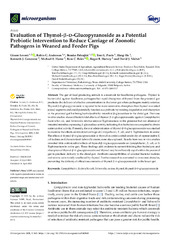Приказ основних података о документу
Evaluation of Thymol-β-d-Glucopyranoside as a Potential Prebiotic Intervention to Reduce Carriage of Zoonotic Pathogens in Weaned and Feeder Pigs
| dc.creator | Levent, Gizem | |
| dc.creator | Anderson, Robin C. | |
| dc.creator | Petrujkić, Branko | |
| dc.creator | Poole, Toni L. | |
| dc.creator | He, Haiqi | |
| dc.creator | Genovese, Kenneth J. | |
| dc.creator | Hume, Michael E. | |
| dc.creator | Beier, Ross C. | |
| dc.creator | Harvey, Roger B. | |
| dc.creator | Nisbet, David J. | |
| dc.date.accessioned | 2021-10-19T18:53:33Z | |
| dc.date.available | 2021-10-19T18:53:33Z | |
| dc.date.issued | 2021 | |
| dc.identifier.issn | 2076-2607 | |
| dc.identifier.uri | https://vet-erinar.vet.bg.ac.rs/handle/123456789/2221 | |
| dc.description.abstract | The gut of food-producing animals is a reservoir for foodborne pathogens. Thymol is bactericidal against foodborne pathogens but rapid absorption of thymol from the proximal gut precludes the delivery of effective concentrations to the lower gut where pathogens mainly colonize. Thymol-β-d-glucopyranoside is reported to be more resistant to absorption than thymol in everted jejunal segments and could potentially function as a prebiotic by resisting degradation and absorption in the proximal gut but being hydrolysable by microbial β-glycosidase in the distal gut. Previous in vitro studies showed bactericidal effects of thymol-β-d-glucopyranoside against Campylobacter, Escherichia coli, and Salmonella enterica serovar Typhimurium in the presence but not absence of intestinal microbes expressing β-glycosidase activity, indicating that hydrolysis was required to obtain antimicrobial activity. Presently, the oral administration of thymol-β-d-glucopyranoside was studied to examine the effects on intestinal carriage of Campylobacter, E. coli, and S. Typhimurium in swine. The effects of thymol-β-d-glucopyranoside or thymol on antimicrobial sensitivity of representative E. coli isolates and characterized Salmonella strains were also explored. Results from two in vivo studies revealed little antimicrobial effects of thymol-β-d-glucopyranoside on Campylobacter, E. coli, or S. Typhimurium in swine gut. These findings add credence to current thinking that hydrolysis and absorption of thymol-β-d-glucopyranoside and thymol may be sufficiently rapid within the proximal gut to preclude delivery to the distal gut. Antibiotic susceptibilities of selected bacterial isolates and strains were mainly unaffected by thymol. Further research is warranted to overcome obstacles, preventing the delivery of efficacious amounts of thymol-β-d-glucopyranoside to the lower gut. | |
| dc.language | en | |
| dc.publisher | MDPI | |
| dc.relation | National Pork Board Grant 14-077 | |
| dc.relation | Research funds appropriated by the United States Department of Agriculture | |
| dc.rights | openAccess | |
| dc.rights.uri | https://creativecommons.org/licenses/by/4.0/ | |
| dc.source | Microorganisms | |
| dc.subject | swine | |
| dc.subject | Campylobacter | |
| dc.subject | Escherichia coli | |
| dc.subject | Salmonella | |
| dc.subject | thymol | |
| dc.subject | thymol-β-d-glucopyranoside | |
| dc.title | Evaluation of Thymol-β-d-Glucopyranoside as a Potential Prebiotic Intervention to Reduce Carriage of Zoonotic Pathogens in Weaned and Feeder Pigs | |
| dc.type | article | en |
| dc.rights.license | BY | |
| dcterms.abstract | Геновесе, Кеннетх Ј.; Петрујкић, Бранко; Хе, Хаиqи; Aндерсон, Робин Ц.; Пооле, Тони Л.; Левент, Гизем; Нисбет, Давид Ј.; Харвеy, Рогер Б.; Беиер, Росс Ц.; Хуме, Мицхаел Е.; | |
| dc.citation.volume | 9 | |
| dc.citation.issue | 4 | |
| dc.citation.spage | 860 | |
| dc.citation.rank | M21 | |
| dc.identifier.wos | 000643309900001 | |
| dc.identifier.doi | 10.3390/microorganisms9040860 | |
| dc.identifier.scopus | 2-s2.0-85104567028 | |
| dc.identifier.fulltext | https://vet-erinar.vet.bg.ac.rs/bitstream/id/6119/microorganisms-09-00860.pdf | |
| dc.type.version | publishedVersion |

